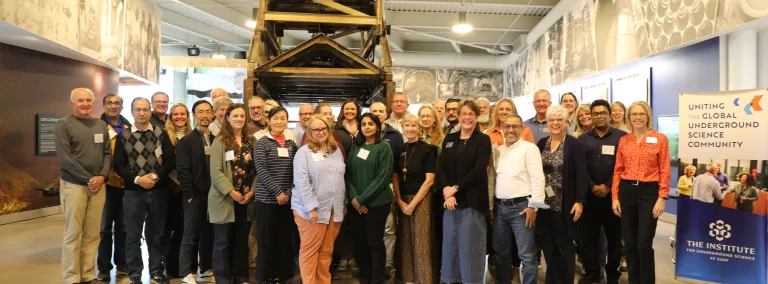Higher Ed Connections Workshop at SURF delves into South Dakota Science and Technology Plan
The Institute for Underground Science at SURF hosted the workshop with a focus on the newly refreshed South Dakota Science and Technology Plan. The event brought together the state’s public and private universities.
Here is a sobering statistic, out of the 50 states, South Dakota is dead last (50th) in investment in academic research and development and near the bottom in business research and development (47th).
The rest of the country, including many neighboring states, are outpacing South Dakota’s investment in the future of high-tech economy—this means the state’s best and brightest graduates often leave for other parts of the country that offer better jobs.
To tackle this problem, South Dakota’s Experimental Program to Stimulate Competitive Research (EPSCoR) office brought together a coalition of leaders from higher education, research institutions, and industry to form the Research Excellence: A Critical Hallmark (REACH) Committee. This spring, the committee published the South Dakota S&T Plan. The plan is a roadmap laying out steps that can begin to improve the state’s high-tech economy, and make it competitive with surrounding states, by 2030.

The Higher Ed Connections Workshop, held recently at the Sanford Underground Research Facility (SURF), was an effort to begin to realize this vision. Jaret Heise, science director at SURF, is one of the members of the REACH Committee who took part in the workshop.
“This is the second year SURF has hosted a meeting in this workshop series, and the update to the SD Science & Technology plan proved to be an excellent rallying point,” said Jaret Heise, science director at SURF. “To overcome challenges and be successful, it is essential that higher education institutions and state partners come together to identify shared priorities, align resources, and strategize collaborative approaches. SURF can contribute a lot in these areas, and we’re happy to be a connector.”
Mel Ustad is the retired director of South Dakota EPSCoR who served as a keynote speaker at the workshop. Ustad touted the role the Institute for Underground Science at SURF is playing by fostering this kind of collaboration.
“More and more science is done by teams and groups of people, not individuals. It's very, very important to get people together and network and talk and get to know each other so that they can come up with innovative, new ideas that work to achieve these goals,” Ustad said.
South Dakota universities, industry, and research institutions can point to many success stories that showcase the value of growing high-tech economy—one of the challenges is communicating the value STEM can bring to the state, the nation, and the world.
“One of the strongest themes from the workshop was the importance of science communication—helping more people see themselves in the story of science,” said Stacie Granum, program manager for The Institute for Underground Science at SURF. “When we connect research to real-world impact and bring students, educators, and communities into that conversation, we create momentum that can transform South Dakota’s innovation landscape.”
Workshop participants spent the last half-day strategizing on next steps and actionable items that can help move the plan forward. Heise points out the data in the state’s S&T plan can provide a measuring stick that monitor progress in the coming years.
“The SD S&T Plan gathers relevant data and highlights some concerning comparisons to other states regarding strategic investments in research and development. These data represent benchmarks we can track to see if the initiatives and high-priority research areas identified in the SD S&T Plan are moving the needle and leading to improvements. Not to mention associated positive returns on industry, state and federal investments that we know will follow,” Heise said.
The students of today are the future STEM workforce and are a key for the long-term success of this plan. Some workshop participants noted it was valuable to explore collaboration opportunities between higher education institutions and research facilities like SURF. The workshop opened the door for expanding research and educational partnerships across institutions in the state.
Deb Wolf is the director of strategic partnerships and external relations at SURF. She noted that unlike larger institutions around the country, many faculty in South Dakota universities are tasked to do both teaching and research—and students are integral to both.
“Throughout the workshop, faculty from across South Dakota brought incredible energy and insight, always circling back to one shared priority — their students,” Wolf said. “SURF is excited to collaborate with our higher-education partners to expand opportunities that connect learning, research, and workforce readiness in powerful new ways.”
It’s the students of today that the South Dakota S&T plan hopes to keep in the state, by investing in the high-tech economy of tomorrow.
“Because you're really building the foundations for the future, the future of the state of South Dakota and even the nation, and getting people together to coalesce and support those efforts are essential,” said Ustad.
The Institute for Underground Science at SURF plans to host the Higher Education Connections Workshop annually at SURF to continue to connect the research happening at universities and institutions across the state with the science and engineering underway at America’s Underground Lab.
